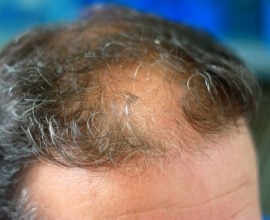Hair Loss in Men
- Hair loss or baldness is defined
- Men and women both experience hair loss
- In men, around 95% of hair loss is a result
Hair loss or baldness is defined
as losing hair from a part of the body though the term is most commonly used for when hair is lost from the head.[1] Medically known as alopecia, the etymology of this term can be traced back to the Classical Greek alōpēx, which means fox.[2] There are two theories on why this Classical Greek word came to be associated with hair loss: 1) because foxes shed their coats twice a year; or 2) because during Ancient Greek times, foxes were susceptible to mange, a skin condition that would cause animals to lose their hair.[3]
Men and women both experience hair loss
sometime in their lives and it not uncommon to lose around 100 hair follicles a day.[4] However, studies have implied that men are more likely to experience hair loss than women – around 4 out 5 men experience some form of hair loss by the time they reach 70 years of age.[5] Hair loss can be temporary or permanent and is caused by a wide range of factors such as genetics, aging, hormonal imbalances and medical conditions.[6]
In men, around 95% of hair loss is a result
of male pattern baldness or androgenic alopecia, which is a genetically inherited medical condition. A distinctive pattern of male pattern baldness starts with hair loss at the temples that gradually recedes back until it forms the typical “M” shape on a male’s head.[7] Hair is also typically lost around the crown area and it occurs because the condition, androgenic alopecia encourages activity of hair follicles’ androgen receptors, which when responding to these upticks of androgens like dihydrotestosterone (DHT) causes hair follicles to dwindle.[8] Due to the fact that men’s bodies product testosterone all their lives, it makes them more genetically predispositioned to hair loss than women – around 70% of men to 40% of women.[9]

Symptoms of hair loss in men can take on many forms,
with the aforementioned male pattern baldness being the most common example. However, some men may also experience circular patchy bald spots, which unlike male pattern baldness’s uniform recession, can appear in random areas on the head.[10] A sign of impending hair loss includes itchy or irritated skin and in some severe cases, hair loss may extend from the scalp to the eyebrows and/or beard areas.[11]
While male pattern baldness is inevitable and unpreventable, men can minimize preventable hair loss by taking care of the current head of hair that they have by being gentle with their hair. To do this, one should invest in a detangler brush and/or wide-tooth comb, which helps to prevent tugging when[12] brushing hair. Male individuals can also limit the amount of harsh hair treatments, hair styles, and hair products to help preserve the hair that they have.
In conclusion, men are most likely to experience permanent hair loss due to a genetic disposition known as androgenic alopecia. This is caused by the fact that men’s bodies continuously product testosterone throughout their lives, which makes this medical condition unpreventable. However, men can minimize preventable hair loss by gently brushing and styling their hair with the correct tools and taking care not to subject their hair follicles to too many chemicals and hard treatments and hair styles.
Sources:
[1] ‘Hair Loss’, in Wikipedia, last edited August 27th, 2020, viewed on September 30, 2020, https://en.wikipedia.org/wiki/Hair_loss#:~:text=Hair%20loss%2C%20also%20known%20as,area%20to%20the%20entire%20body.
[2] ibid
[3] ibid
[4] Osborn Jacob, ‘6 Common Hair Loss Causes In Men’, in MANOFMANY, published May 21st, 2020, viewed on September 30, 2020, https://manofmany.com/lifestyle/advice/common-hair-loss-causes-in-men
[5] ‘What Causes Hair Loss In Men?’ in WebMD, viewed on September 30, 2020, https://www.webmd.com/skin-problems-and-treatments/hair-loss/men-hair-loss-causes#1
[6] Mayo Clinic Staff, ‘Hair Loss’, in Mayo Clinic, last updated May 22nd, 2020, viewed on September 30, 2020, https://www.mayoclinic.org/diseases-conditions/hair-loss/symptoms-causes/syc-20372926
[7] ‘Why Is Hair Loss More Common in Men Than Women?’, in Wimpole Clinic, viewed on September 30, 2020, https://wimpoleclinic.com/blog/why-is-hair-loss-more-common-in-men-than-women/
[8] ibid
[9] ibid
[11] ibid
[12] Mayo Clinic Staff, ‘Hair Loss’, in Mayo Clinic, last updated May 22nd, 2020, viewed on September 30, 2020, https://www.mayoclinic.org/diseases-conditions/hair-loss/symptoms-causes/syc-20372926














